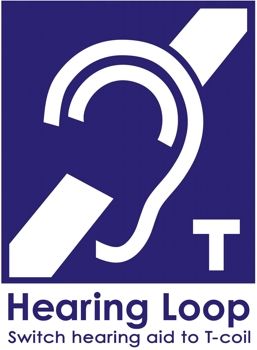
Now is the Right Time to Advocate for Hearing Loops
Communications challenges continue
The COVID-19 threat is not going away anytime soon. Those with hearing loss have experienced added limitations to communication during these times of social distancing, self-quarantine, masked outings and conversations. Being talked to through plastic or glass partitions further worsens the muffling of sounds. Speechreading (lipreading) has become impossible, which deepens the feelings of isolation for deaf and hard-of-hearing people.
Now, as society gradually reopens ever so hesitantly, continued distancing and mask requirements will remain in effect and so will the communication challenges. Sitting up front, close to the speaker is a thing of the past. “Up close” is a lot further back these days.
Hearing Loops could help
Wouldn’t it be nice to connect via telecoil or T-coil to hearing loops installed at bank and pharmacy windows, at information desks, in class rooms, libraries, places of worship and in health facilities? Gone would be the background noise and speech would be so much easier to understand – without the struggle, the fatigue and the embarrassment.
Good news: One does not need to be hard-of-hearing or to have hearing aids in order to enjoy listening through a loop. With the help of a headset or earbuds, any portable device with a telecoil provides loop access.
It is often said that anybody who has ever listened to speech through a correctly installed hearing loop does not want to turn back. As we go forward into a shaky communication future, it is more important than ever for those with hearing loss to get into the loop. Let’s not be left out – again!
Hearing loops are different from proprietary, short-distance Bluetooth. A hearing loop is a special electrical wire that is installed or looped throughout or around the area that is to be made accessible.
Telecoils or T-coils are tiny wireless antennas that can be found in cochlear implants, hearing aids and hearing devices large enough to accommodate them. With the hearing aids in T-Mode, they allow the user to tap into the sound energy carried by the magnetic field that surrounds a hearing loop that is in service. Together, loops and telecoils act as assistive listening “systems.”
It is the Right time to advocate
At this point, communication challenges of all kinds are an acute issue for those with hearing loss. Therefore, it makes so much sense that now is the right time to advocate for the installation of hearing loops.
It is also a prime time for asking hearing specialists whether the hearing aids that we plan to buy have telecoils. Most people do not know because they have never been told about them. Yet, in order to work, the hearing specialist must tune the telecoils to the hearing needs of the client. He/she must activate them and instruct the client on how and where to use them.
The future of access is up to the people
Do people with hearing loss want to be connected and included as communication snags pile up? If yes, it is time to act. Hearing loops do not magically appear. The technology needs advocates and believers who make the case for much-needed accessibility.
And so, what will our communication future look like? As President Abraham Lincoln told us “The best way to predict the future is to create it.” And the time to become “creative” and motivated is now.
****
Meet me online:
Guess what! I do ZOOM presentations! Nice way to talk to people across the nation.
Email: [email protected]
Visit my website hearing-loss-talk.com
Join me on Facebook: https://www.facebook.com/whatdidyousaybook/
I even Tweet: @WhatDidYouSay88